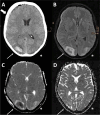Posterior reversible encephalopathy syndrome associated with antibiotic therapy: a case report and systematic review
- PMID: 38679625
- PMCID: PMC11306538
- DOI: 10.1007/s10072-024-07545-1
Posterior reversible encephalopathy syndrome associated with antibiotic therapy: a case report and systematic review
Abstract
Posterior reversible encephalopathy syndrome (PRES) is an acute neurological condition associated with different etiologies, including antibiotic therapy. To date, most data regarding antibiotic-related PRES are limited to case reports and small case series. Here, we report a novel case description and provide a systematic review of the clinico-radiological characteristics and prognosis of available cases of PRES associated with antibiotic therapy. We performed a systematic literature search in PubMed and Scopus from inception to 10 January 2024, following PRISMA guidelines and a predefined protocol. The database search yielded 12 subjects (including our case). We described the case of a 55-year-old female patient with PRES occurring one day after administration of metronidazole and showing elevated serum neurofilament light chain protein levels and favorable outcome. In our systematic review, antibiotic-associated PRES was more frequent in female patients (83.3%). Metronidazole and fluoroquinolones were the most reported antibiotics (33.3% each). Clinical and radiological features were comparable to those of PRES due to other causes. Regarding the prognosis, about one third of the cases were admitted to the intensive care unit, but almost all subjects (90.0%) had a complete or almost complete clinical and radiological recovery after prompt cessation of the causative drug. Antibiotic-associated PRES appears to share most of the characteristics of classic PRES. Given the overall good prognosis of the disease, it is important to promptly diagnose antibiotic-associated PRES and discontinue the causative drug.
Keywords: Adverse drug reactions; Antibiotics; Metronidazole; Neurofilament light chain; PRES; Posterior reversible encephalopathy syndrome.
© 2024. The Author(s).
Conflict of interest statement
The authors have no competing interests to declare that are relevant to the content of this article.
Figures


References
Publication types
MeSH terms
Substances
LinkOut - more resources
Full Text Sources
Medical

